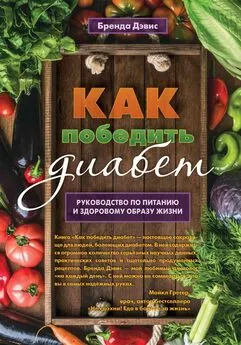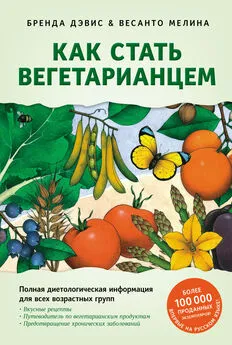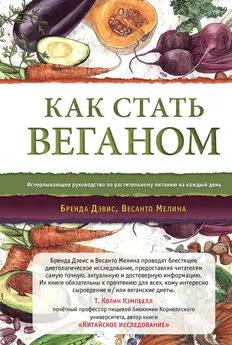Бренда Дэвис - Как победить диабет. Руководство по питанию и образу жизни
- Название:Как победить диабет. Руководство по питанию и образу жизни
- Автор:
- Жанр:
- Издательство:Ганга
- Год:2021
- Город:Москва
- ISBN:978-5-907243-84-2
- Рейтинг:
- Избранное:Добавить в избранное
-
Отзывы:
-
Ваша оценка:
Бренда Дэвис - Как победить диабет. Руководство по питанию и образу жизни краткое содержание
Как победить диабет. Руководство по питанию и образу жизни - читать онлайн бесплатно ознакомительный отрывок
Интервал:
Закладка:
76. Fritsche KL. The science of fatty acids and inflammation. Adv Nutr. 2015; 6(3): 293S–301S.
77. Newsholme P, Keane D, Welters HJ, Morgan NG. Life and death decisions of the pancreatic b-cell: the role of fatty acids. Clin Sci . 2007; 112(1): 27–42.
78. Sacks FM, Lichtenstein AH, Wu JHY, et al. Dietary fats and cardiovascular disease: A presidential advisory from the American Heart Association. Circulation . 2017; 136(3): e1–e23.
79. U.S. Deparment of Agriculture. Agriculture Research Service. Nutrient Data Library. USDA National Nutrition Database for Standard Reference, Legacy Version Current: April 2018. URL: https://ndb.nal.usda.gov/ndb/search/list.
80. Fabricio G, Malta A, Chango A, De Freitas Mathias PC. Environmental contaminants and pancreatic beta-cells. J Clin Res Pediatr Endocrinol . 2016; 8(3): 257–263.
81. Magliano DJ, Loh VHY, Harding JL, et al. Persistent organic pollutants and diabetes: A review of the epidemiological evidence. Diabetes Metab . 2014; 40(1): 1–14.
82. EFSA. Cadmium dietary exposure. EFSA Journal. 2012; 10(1): 1–37.
83. Evangelou E, Ntritsos G, Chondrogiorgi M, et al. Exposure to pesticides and diabetes: A systematic review and meta-analysis. Environ Int . 2016; 91: 60–68.
84. Liu G, Zong G, Wu K, et al. Meat cooking methods and risk of type 2 diabetes: Results from three prospective cohort studies. Diabetes Care . 2018; 41(5): 1049–1060.
85. Stallings-Smith S, Mease A, Johnson TM, Arikawa AY. Exploring the association between polycyclic aromatic hydrocarbons and diabetes among adults in the United States. Environ Res . 2018; 166: 588–594.
86. Abdel-Shafy HI, Mansour MSM. A review on polycyclic aromatic hydrocarbons: Source, environmental impact, effect on human health and remediation. Egypt J Pet . 2016; 25(1): 107–123.
87. Vlassara H, Uribarri J. Advanced Glycation End Products (AGE) and Diabetes: Cause, Effect, or Both? Curr Diab Rep . 2014; 14(1): 453.
88. Nowotny K, Jung T, Höhn A, Weber D, Grune T. Advanced glycation end products and oxidative stress in type 2 diabetes mellitus. Biomolecules . 2015; 5(1): 194–222.
89. Velasquez MT, Ramezani A, Manal A, Raj DS. Trimethylamine n-oxide: The good, the bad and the unknown. Toxins (Basel) . 2016; 8(11).
90. Janeiro M, Ramírez M, Milagro F, et al. Implication of trimethylamine n-oxide (tmao) in disease: Potential biomarker or new therapeutic target. Nutrients . 2018; 10(10): 1398.
91. Samraj AN, Pearce OMT, Läubli H, et al. A red meat-derived glycan promotes inflammation and cancer progression. Proc Natl Acad Sci . 2015; 112(2): 542–547.
92. Alisson-Silva F, Kawanishi K, Varki A. Human risk of diseases associated with red meat intake: Analysis of current theories and proposed role for metabolic incorporation of a non-human sialic acid. Mol Aspects Med . 2016; 51: 16–30.
93. Erridge C. The capacity of foodstuffs to induce innate immune activation of human monocytes in vitro is dependent on food content of stimulants of Toll-like receptors 2 and 4. Br J Nutr . 2011; 105(01): 15–23.
94. Piya MK, Harte AL, McTernan PG. Metabolic endotoxaemia: Is it more than just a gut feeling? Curr Opin Lipidol . 2013; 24(1): 78–85.
95. Fei N, Zhao L. An opportunistic pathogen isolated from the gut of an obese human causes obesity in germfree mice. ISME J . 2013; 7(4): 880–884.
96. White D, Collinson A. Red meat, dietary heme iron, and risk of type 2 diabetes: The involvement of advanced lipoxidation endproducts. Adv Nutr . 2013; 4: 403–411.
97. Radzeviciene L, Ostrauskas R. Adding salt to meals as a risk factor of type 2 diabetes mellitus: A case-control study. Nutrients . 2017; 9(1): 67.
98. Horikawa C, Yoshimura Y, Kamada C, et al. Dietary sodium intake and incidence of diabetes complications in Japanese patients with type 2 diabetes: analysis of the Japan Diabetes Complications Study (JDCS). J Clin Endocrinol Metab . 2014; 99(10): 3635–3643.
99. Colosia AD, Palencia R, Khan S. Prevalence of hypertension and obesity in patients with type 2 diabetes mellitus in observational studies: a systematic literature review. Diabetes Metab Syndr Obes . 2013; 6: 327–338.
100. Suckling RJ, He FJ, Markandu ND, MacGregor GA. Modest salt reduction lowers blood pressure and albumin excretion in impaired glucose tolerance and type 2 diabetes mellitus. Hypertension . 2016; 67(6): 1189–1195.
101. Purohit V, Mishra S. The truth about artificial sweeteners – Are they good for diabetics? Indian Heart J . 2018; 70(1): 197–199.
102. Fagherazzi G, Gusto G, Affret A, et al. Chronic consumption of artificial sweetener in packets or tablets and type 2 diabetes risk: Evidence from the E3N-European Prospective Investigation into Cancer and Nutrition Study. Ann Nutr Metab . 2017; 70(1): 51–58.
103. Suez J, Korem T, Zeevi D, et al. Artificial sweeteners induce glucose intolerance by altering the gut microbiota. Nature . 2014; 514(7521): 181–186.
104. Talaei M, Wang Y-L, Yuan J-M, Pan A, Koh W-P. Meat, dietary heme iron, and risk of type 2 diabetes mellitus: The Singapore Chinese Health Study. Am J Epidemiol . 2017; 186(7): 824–833.
105. Osorio-Yáñez C, Gelaye B, Qiu C, et al. Maternal intake of fried foods and risk of gestational diabetes mellitus. Ann Epidemiol . 2017; 27(6): 384–390.e1.
106. Schumacher L, Abbott LC. Effects of methyl mercury exposure on pancreatic beta cell development and function. J Appl Toxicol . 2017; 37(1): 4–12.
107. Brouwer-Brolsma EM, Sluik D, Singh-Povel CM, Feskens EJM. Dairy product consumption is associated with pre-diabetes and newly diagnosed type 2 diabetes in the Lifelines Cohort Study. Br J Nutr . 2018; 119(04): 442–455.
108. Drouin-Chartier J-P, Brassard D, Tessier-Grenier M, et al. Systematic review of the association between dairy product consumption and risk of cardiovascular-related clinical outcomes. Adv Nutr . 2016; 7(6): 1026–1040.
109. Virtanen JK, Mursu J, Tuomainen T-P, et al. Egg consumption and risk of incident type 2 diabetes in men: The Kuopio Ischaemic Heart Disease Risk Factor Study. Am J Clin Nutr . 2015; 101(5): 1088–1096.
110. Djoussé L, Petrone AB, Hickson DA, et al. Egg consumption and risk of type 2 diabetes among African Americans: The Jackson Heart Study. Clin Nutr . 2016; 35(3): 679–684.
111. Jang J, Shin M-J, Kim OY, Park K. Longitudinal association between egg consumption and the risk of cardiovascular disease: Interaction with type 2 diabetes mellitus. Nutr Diabetes . 2018; 8(1): 20.
112. Hu EA, Pan A, Malik V, Sun Q. White rice consumption and risk of type 2 diabetes: meta-analysis and systematic review. BMJ . 2012; 344: e1454.
113. Zhou J, Sheng J, Fan Y, et al. Dietary patterns, dietary intakes and the risk of type 2 diabetes: Results from the Hefei Nutrition and Health Study. Int J Food Sci Nutr . 2018: 1–9. (epub ahead of print).
114. AlEssa HB, Bhupathiraju SN, Malik VS, et al. Carbohydrate quality and quantity and risk of type 2 diabetes in US women. Am J Clin Nutr . 2015; 102(6): 1543–1553.
115. Malik VS, Popkin BM, Bray GA, et al. Sugar-sweetened beverages and risk of metabolic syndrome and type 2 diabetes: a meta-analysis. Diabetes Care . 2010; 33(11): 2477–2483.
116. Medina-Remón A, Kirwan R, Lamuela-Raventós RM, Estruch R. Dietary patterns and the risk of obesity, type 2 diabetes mellitus, cardiovascular diseases, asthma, and neurodegenerative diseases. Crit Rev Food Sci Nutr . 2018; 58(2): 262–296.
117. Schwingshackl L, Hoffmann G. Diet quality as assessed by the healthy eating index, the alternate healthy eating index, the dietary approaches to stop hypertension score, and health outcomes: A systematic review and meta-analysis of cohort studies. J Acad Nutr Diet . 2015; 115(5): 780–800.e5.
118. Odegaard AO, Koh WP, Yuan J-M, Gross MD, Pereira MA. Western-style fast food intake and cardiometabolic risk in an Eastern country. Circulation . 2012; 126(2): 182–188.
119. Mezuk B, Li X, Cederin K, et al. Beyond Access: characteristics of the food environment and risk of diabetes. Am J Epidemiol . 2016; 183(12): 1129–1137.
120. Bao W, Tobias DK, Olsen SF, Zhang C. Pre-pregnancy fried food consumption and the risk of gestational diabetes mellitus: a prospective cohort study. Diabetologia . 2014; 57(12): 2485–2491.
Глава 4
1. World Health Organization. Obesity and Overweight Factsheet. 2003. URL: https://www.who.int/dietphysicalactivity/ media/en/gsfs_obesity.pdf. Accessed January 21, 2019.
2. Clifton P. Assessing the evidence for weight loss strategies in people with and without type 2 diabetes. World J Diabetes . 2017; 8(10): 440–454.
3. Rehackova L, Araújo-Soares V, Adamson AJ, et al. Acceptability of a very-low-energy diet in type 2 diabetes: patient experiences and behavior regulation. Diabet Med . 2017; 34(11): 1554–1567.
4. Tonstad S, Butler T, Yan R, Fraser GE. Type of vegetarian diet, body weight, and prevalence of type 2 diabetes. Diabetes Care . 2009; 32(5): 791–796.
5. Spencer EA, Appleby PN, Davey GK, Key TJ. Diet and body mass index in 38000 EPIC-Oxford meat-eaters, fish-eaters, vegetarians and vegans. Int J Obes . 2003; 27(6): 728–734.
6. Jackson AS, Ellis KJ, McFarlin BK, Sailors MH, Bray MS. Body mass index bias in defining obesity of diverse young adults: The Training Intervention and Genetics of Exercise Response (TIGER) Study. Br J Nutr . 2009; 102(07): 1084.
7. Campbell MC, Tishkoff SA. African genetic diversity: implications for human demographic history, modern human origins, and complex disease mapping. Annu Rev Genomics Hum Genet . 2008; 9(1): 403–433.
8. Shiwaku K, Anuurad E, Enkhmaa B, et al. Overweight Japanese with body mass indexes of 23.0–24.9 have higher risks for obesity-associated disorders: a comparison of Japanese and Mongolians. Int J Obes Relat Metab Disord . 2004; 28(1): 152–158.
9. Gray LJ, Yates T, Davies MJ, et al. Defining obesity cut-off points for migrant South Asians. PLoS One . 2011; 6(10): 4–10.
10. Nishida C. Appropriate body-mass index for Asian populations and its implications for policy and intervention strategies. Lancet . 2004; 363(9403): 157–163.
11. Center for Health Statistics N. Table 53. Selected health conditions and risk factors, by age: United States, selected years 1988–1994 through 2015–2016; 2017. URL: https://www.cdc.gov/ nchs/hus/contents2017.htm#053. Accessed January 21, 2019.
12. Corsica JA, Pelchat ML. Food addiction: true or false? Curr Opin Gastroenterol . 2010; 26(2): 165–169.
13. Ifland JR, Preuss HG, Marcus MT, et al. Refined food addiction: a classic substance use disorder. Med Hypotheses . 2009; 72(5): 518–526.
14. Liu Y, von Deneen KM, Kobeissy FH, Gold MS. Food addiction and obesity: Evidence from bench to bedside. J Psychoactive Drugs . 2010; 42(2): 133–145.
15. Holtcamp W. Obesogens: An environmental link to obesity. Environ Health Perspect . 2012; 120(2): a62–68.
16. Grün F, Blumberg B. Minireview: The case for obesogens. Mol Endocrinol . 2009; 23(8): 1127–1134.
17. Janesick A, Blumberg B. Endocrine disrupting chemicals and the developmental programming of adipogenesis and obesity. Birth Defects Res C Embryo Today . 2011; 93(1): 34–50.
Читать дальшеИнтервал:
Закладка:




![Карин Дина - Справочник сыроеда [Краткое руководство по питанию свежей растительной пищей]](/books/1060242/karin-dina-spravochnik-syroeda-kratkoe-rukovodstvo.webp)





